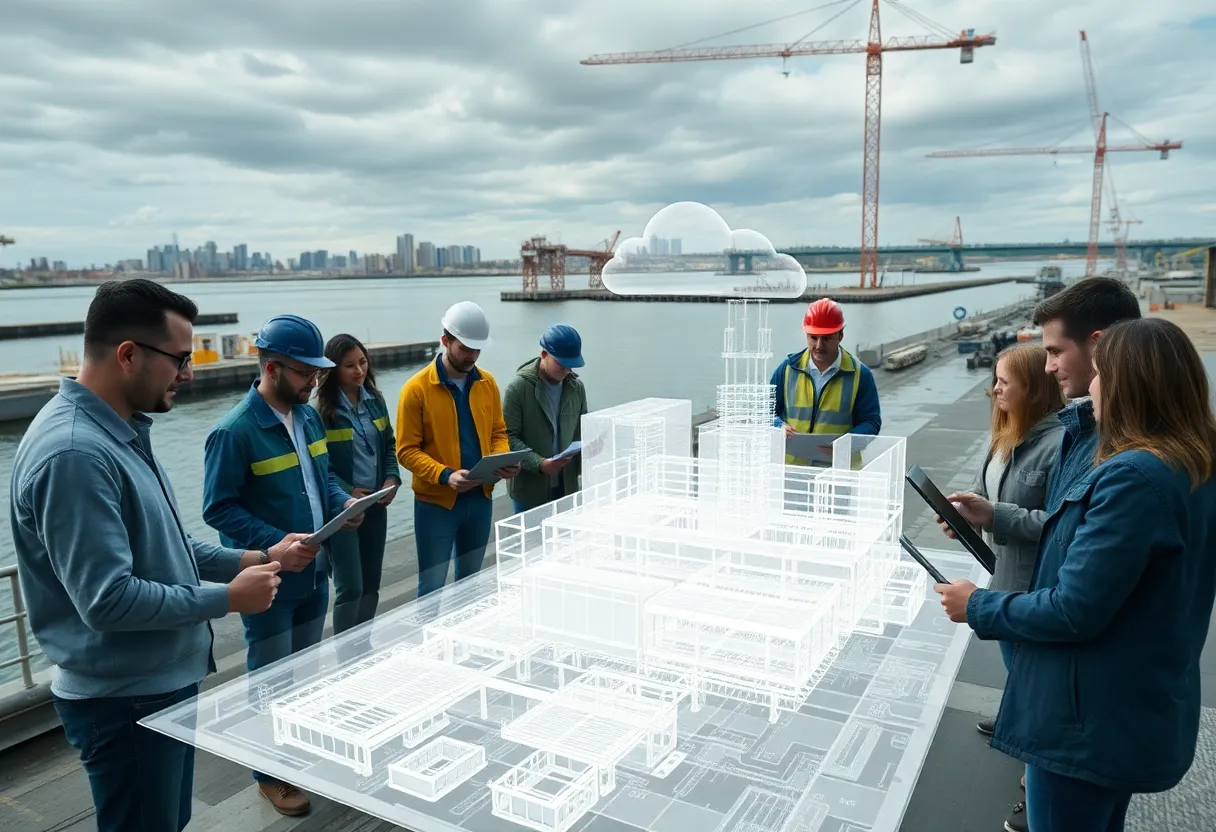Buffalo, New York, October 7, 2025
News Summary
The global Building Information Modeling (BIM) market is poised for rapid expansion, driven by advances in cloud computing, AI, VR/AR and IoT. Research forecasts significant market growth and strong CAGR as public and private sectors adopt BIM for complex projects, sustainability and smart-city initiatives. The USACE Buffalo District is applying BIM to infrastructure projects like Black Rock Lock miter gates and remediation at the Niagara Falls Store Site, reporting benefits in planning, clash detection and maintenance while facing challenges in file compatibility and data standards. Federal grants and labor dynamics further propel adoption across the industry.
Global BIM Market Seen Triple by 2030 as Agencies and Contractors Expand Use
The global market for Building Information Modeling (BIM) was estimated at US$8.6 billion in 2023. Research released with a Dublin dateline in late October 2024 projects the market will expand sharply, driven by tougher project requirements, public-sector mandates, and new technology that makes models more useful through a building’s life.
Key market numbers and forecast
ResearchAndMarkets projects the global BIM market will reach US$24.8 billion by 2030. The same source projects a compound annual growth rate (CAGR) of 16.3% for BIM from 2023 to 2030. Those figures sit atop a list of reasons companies and agencies are moving faster to adopt BIM tools, from design coordination to operations and maintenance.
Why adoption is rising
Several practical pressures are pushing BIM into more projects. Modern building efforts are more complex, often combining structural, mechanical and electrical work in tight spaces, and BIM lets those disciplines work on a single, shared digital model. Public projects in many countries now come with rules that require or strongly encourage BIM on large infrastructure and public-sector work, which boosts demand.
Sustainability goals and the rise of smart city planning feed BIM uptake as well. BIM supports energy modeling and lifecycle analysis, and it ties into smart-city data for planning, design and maintenance. Labor shortages and a shrinking craft workforce also make digital tools appealing: BIM can automate elements of design and coordination so smaller teams can handle bigger projects.
Technology is making BIM more powerful
Cloud computing, artificial intelligence (AI), virtual and augmented reality (VR/AR), and the Internet of Things (IoT) are enhancing BIM. Cloud systems let teams share and update models in real time. AI can add predictive analytics to spot schedule or material risks before they cause delays. VR/AR lets stakeholders walk through a design before construction starts, and IoT connects live sensor data to models for ongoing performance tracking.
Benefits across the project lifecycle
BIM replaces fragmented 2D drawings with a cohesive 3D model that holds detailed data on every component, from structure to HVAC and electrical systems. This approach helps teams spot design clashes early, reduces costly rework, supports better visualization of future performance, and provides a living record that owners can use for operations and maintenance.
Government and federal programs
Federal grant programs are encouraging adoption. The Federal Highway Administration disbursed grants worth $16.6 million to eight states under the Advanced Digital Construction Management Systems program last November, a direct push to bring digital tools into state transportation project delivery.
USACE Buffalo District: a case study
The Buffalo District has started using BIM. The Buffalo District is using BIM to model projects such as miter gates for the Black Rock Lock in downtown Buffalo. The Buffalo District is using BIM for remediation work at the Niagara Falls Store Site. ERDC documented the Fort Meade project and listed major benefits of BIM. The Buffalo District faces practical challenges with BIM, including ensuring file compatibility and enforcing data standards, and the district views BIM as an investment in future technology. District staff report that the scope of collected data helps to plan projects, design repairs or upgrades, track construction progress, monitor changes over time, and maintain and manage infrastructure. Agency adoption in this case aligns with a wider government push for modernization, digital transformation and improved data management in infrastructure delivery.
Private sector use and examples
Contractors have long used BIM for coordination and prefabrication. One example in large-scale renovation work leaned heavily on design-assist and digital modeling to integrate systems across multiple historic buildings. Prefabrication and modular construction trends also rely on BIM for precise coordination and planning.
Reports and market materials
A market report with a Dublin, Oct. 31, 2024 dateline was added to a commercial market research offering and includes market trends, drivers, forecasts, and profiles of 22 featured players. The release encourages readers to purchase the full report for in-depth coverage and provides a reference URL for more information.
Industry context
Broader industry analyses show construction spending remained high in 2024, with government investment a key driver and ongoing talent shortages shaping decisions to invest in digital tools. Firms are exploring digital twins, connected construction, drones for surveying and inspection, and AI-enabled workflows to boost productivity and manage specialized labor demands for megaprojects and data centers.
Bottom line
BIM adoption is accelerating across public and private sectors because it addresses coordination, sustainability, and lifecycle management needs while riding improvements in cloud, AI, VR/AR and IoT. Forecasts show a rapid market expansion through 2030, and public programs and agency pilots are helping spread the technology into standard project delivery.
FAQ
What was the size of the global BIM market in 2023?
The global market for Building Information Modeling (BIM) was estimated at US$8.6 billion in 2023.
What is the projected size of the BIM market by 2030?
ResearchAndMarkets projects the global BIM market will reach US$24.8 billion by 2030.
What growth rate is projected for BIM through 2030?
ResearchAndMarkets projects a compound annual growth rate (CAGR) of 16.3% for BIM from 2023 to 2030.
Has the Buffalo District started using BIM?
The Buffalo District has started using BIM.
What projects is the Buffalo District modeling with BIM?
The Buffalo District is using BIM to model projects such as miter gates for the Black Rock Lock in downtown Buffalo.
Is the Buffalo District using BIM for remediation work?
The Buffalo District is using BIM for remediation work at the Niagara Falls Store Site.
What challenges does the Buffalo District face with BIM?
Challenges the Buffalo District faces with BIM include ensuring file compatibility and enforcing data standards.
How does the Buffalo District view BIM?
The Buffalo District views BIM as an investment in future technology.
Did the Federal Highway Administration provide grants related to digital construction?
Federal Highway Administration disbursed grants worth $16.6 million to eight states under the Advanced Digital Construction Management Systems program.
{
“@context”: “https://schema.org”,
“@type”: “FAQPage”,
“mainEntity”: [
{
“@type”: “Question”,
“name”: “What was the size of the global BIM market in 2023?”,
“acceptedAnswer”: {
“@type”: “Answer”,
“text”: “The global market for Building Information Modeling (BIM) was estimated at US$8.6 billion in 2023.”
}
},
{
“@type”: “Question”,
“name”: “What is the projected size of the BIM market by 2030?”,
“acceptedAnswer”: {
“@type”: “Answer”,
“text”: “ResearchAndMarkets projects the global BIM market will reach US$24.8 billion by 2030.”
}
},
{
“@type”: “Question”,
“name”: “What growth rate is projected for BIM through 2030?”,
“acceptedAnswer”: {
“@type”: “Answer”,
“text”: “ResearchAndMarkets projects a compound annual growth rate (CAGR) of 16.3% for BIM from 2023 to 2030.”
}
},
{
“@type”: “Question”,
“name”: “Has the Buffalo District started using BIM?”,
“acceptedAnswer”: {
“@type”: “Answer”,
“text”: “The Buffalo District has started using BIM.”
}
},
{
“@type”: “Question”,
“name”: “What projects is the Buffalo District modeling with BIM?”,
“acceptedAnswer”: {
“@type”: “Answer”,
“text”: “The Buffalo District is using BIM to model projects such as miter gates for the Black Rock Lock in downtown Buffalo.”
}
},
{
“@type”: “Question”,
“name”: “Is the Buffalo District using BIM for remediation work?”,
“acceptedAnswer”: {
“@type”: “Answer”,
“text”: “The Buffalo District is using BIM for remediation work at the Niagara Falls Store Site.”
}
},
{
“@type”: “Question”,
“name”: “What challenges does the Buffalo District face with BIM?”,
“acceptedAnswer”: {
“@type”: “Answer”,
“text”: “Challenges the Buffalo District faces with BIM include ensuring file compatibility and enforcing data standards.”
}
},
{
“@type”: “Question”,
“name”: “How does the Buffalo District view BIM?”,
“acceptedAnswer”: {
“@type”: “Answer”,
“text”: “The Buffalo District views BIM as an investment in future technology.”
}
},
{
“@type”: “Question”,
“name”: “Did the Federal Highway Administration provide grants related to digital construction?”,
“acceptedAnswer”: {
“@type”: “Answer”,
“text”: “Federal Highway Administration disbursed grants worth $16.6 million to eight states under the Advanced Digital Construction Management Systems program.”
}
}
]
}
Key Features Table
| Feature | Detail |
|---|---|
| Market size (2023) | US$8.6 billion |
| Projected market (2030) | US$24.8 billion |
| Projected CAGR (2023–2030) | 16.3% |
| Primary drivers | Project complexity, government mandates, sustainability, smart cities, labor shortages, prefabrication |
| Core technology enablers | Cloud computing, AI, VR/AR, IoT |
| Public-sector adoption example | Buffalo District modeling miter gates for Black Rock Lock and remediation at Niagara Falls Store Site |
| Public funding | Federal Highway Administration disbursed grants worth $16.6 million to eight states under the Advanced Digital Construction Management Systems program |
| Report coverage | Market trends, drivers, forecasts, and 22 featured players |
| Common operational benefits | Clash detection, visualization, lifecycle records for operations and maintenance |
Deeper Dive: News & Info About This Topic
Additional Resources
- Construction Dive: USACE Buffalo District adopts BIM
- Wikipedia: Building information modeling
- Deloitte: Engineering and Construction industry outlook
- Google Search: Construction industry trends 2024
- G2 Learn: Construction statistics
- Google Scholar: Construction statistics 2024
- GlobeNewswire: Building Information Modeling (BIM) Industry research 2024
- Encyclopedia Britannica: Building information modeling
- BusinessWire: Artificial Intelligence (AI) in Construction report
- Google News: AI in construction
Author: Construction CA News
The CALIFORNIA STAFF WRITER represents the experienced team at constructioncanews.com, your go-to source for actionable local news and information in California and beyond. Specializing in "news you can use," we cover essential topics like product reviews for personal and business needs, local business directories, politics, real estate trends, neighborhood insights, and state news affecting the area—with deep expertise drawn from years of dedicated reporting and strong community input, including local press releases and business updates. We deliver top reporting on high-value events such as the Rose Parade, Coachella, Comic-Con, and the California State Fair. Our coverage extends to key organizations like the California Building Industry Association and Associated General Contractors of California, plus leading businesses in technology and entertainment that power the local economy such as Apple and Alphabet. As part of the broader network, including constructionnynews.com, constructiontxnews.com, and constructionflnews.com, we provide comprehensive, credible insights into the dynamic landscape across multiple states.




